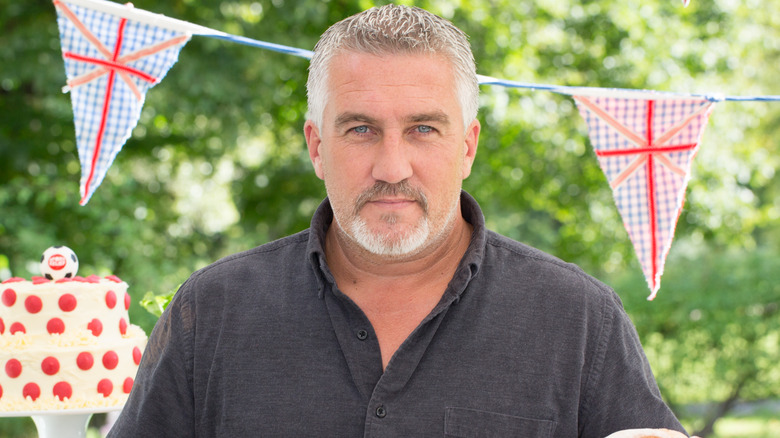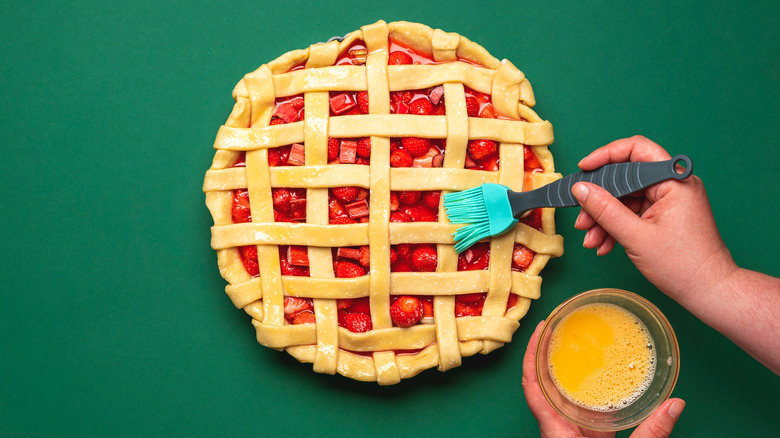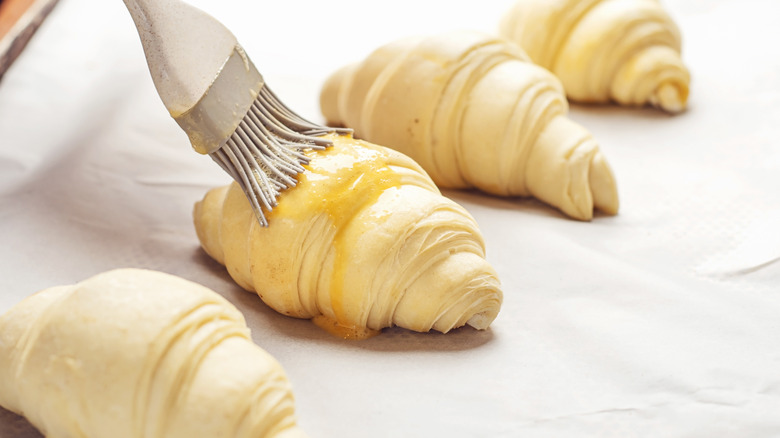The Extra Step You Need To Take For Better Egg Wash, According To Paul Hollywood
When you see beautifully burnished bakes and pastries on TV cooking shows or social media, the secret to that gloriously golden and glossy finish is often egg wash. The protein and fat in the egg work wonders for adding both color and shininess. But if you want to get a professional-looking shine on your pie crust or homemade classic butter croissant, it's worth taking a tip from the experts — and for Paul Hollywood, that means adding some salt to the egg.
Salt adds flavor, and it also works as a flavor enhancer. It elevates both sweet and savory notes within the pastry and reduces any unwanted bitterness. It helps to balance out the overall sweetness and naturally amplifies the taste of other ingredients – such as the tartness of fruit or the complexity of chocolate. It even makes the bake smell better, for that unbeatable mouthwatering aroma when you take it out of the oven.
But salt has another vital function in egg wash, too. It actually alters the structure of the liquid due to the way it denatures the proteins within the egg, making the glaze thinner and easier to use. For professionals like "The Great British Baking Show" star Hollywood, this consistency helps to give baked goods a more even finish, as well as making the end result more flavorsome.
Salt breaks down the proteins for a more even egg wash
Adding a pinch of salt to eggs breaks them down by making the proteins in the yolk less attracted to each other, so they become less tightly bound, and the mixture becomes runnier. It takes around 15 minutes for salt to fully absorb, so let the mixture sit for a little while before applying it.
The looser, smoother texture created by the salt makes the mixture easier to spread, which is especially useful when you're trying to evenly coat a delicate pastry with a fragile texture. You can either apply one thin even coating of glaze or build it up with multiple thin layers for a richer-looking result. If doing two or three layers, put the bake in the fridge for a few minutes between each to make it easier to apply. But don't be tempted to brush on too much, as excess pools of the egg mixture can burn during cooking as well as give an uneven finish.
Paul Hollywood's top tip when glazing different types of sweet scones for tea parties is to only brush the salted egg mixture on the top, and not down the sides. The heat of the oven causes the eggs to "solidify like a glue," he explains, so applying it to the sides can prevent the dough or pastry from rising (via the BBC). This also applies to items such as multi-layered puff pastry, which expands when cooked.
More tips for a better egg wash
If you want even more rich flavor and color in your egg wash, then consider adding spices in addition to Paul Hollywood's recommendation of salt. For savory bakes, try turmeric for a sunshine yellow hue or paprika for a deeper orange. You could use nutmeg or cinnamon if it's a sweet pie or pastry.
It's easy to adjust egg wash for your ideal crust color by using different parts of the egg. Just the yolks will give a richer, deeper color whereas only the whites will result in a shiny glaze but lighter color. Or try using the whole egg plus a splash of whole milk, cream, or water, which gives a nicely golden and glossy result — and, as with salt, gives a runnier texture that's easier to apply evenly. Use a silicone brush for the least mess, as natural bristles can clump together and are trickier to clean.
If you have any egg wash leftover after glazing your bake, don't throw it out. Keep it in an airtight container in the fridge, and it will stay fresh for a couple of days. But if you're pushed for time, or just fancy something different, then you can use mayo in place of egg wash. It adds a nice touch of acidity and, since the egg-based condiment contains fat, you'll also get a decent shine. It works especially well on savory pie crusts. Or try olive oil for a plant-based alternative.



